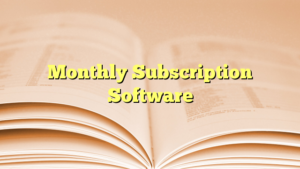Subscription Software Examples: A Comprehensive Guide
In today’s digital era, subscription-based software has become a popular business model that offers a continuous stream of revenue for software companies. With the increasing demand for software applications and the flexibility that subscription-based models offer, more and more companies are adopting this model. In this article, we will discuss subscription software examples that have revolutionized the industry.
Table of Contents
- Introduction
- What is Subscription-Based Software?
- Benefits of Subscription-Based Software
- Popular Subscription-Based Software Examples
- Microsoft 365
- Adobe Creative Cloud
- Shopify
- Dropbox
- Netflix
- Salesforce
- Hootsuite
- Zoom
- Slack
- Canva
- How to Choose the Right Subscription-Based Software?
- Conclusion
- FAQs
Introduction
In the past decade, the subscription model has taken over the software industry. This model has provided businesses with a predictable revenue stream while allowing customers to access software without the burden of high upfront costs. In this article, we will discuss subscription software examples that have transformed the industry and explore the benefits of subscription-based models.
What is Subscription-Based Software?
Subscription-based software is a business model where users pay a recurring fee to access a software application. This model allows businesses to generate a continuous stream of revenue while providing users with the flexibility to use the software without any long-term commitment. With subscription-based models, software companies can provide regular updates and improvements to the software without requiring customers to pay for a new version.
Benefits of Subscription-Based Software
- Predictable revenue stream: Subscription-based models offer a consistent revenue stream, which is crucial for software companies to plan their finances.
- Improved customer retention: With regular updates and improvements to the software, customers are more likely to remain loyal to the software.
- Access to the latest features: Customers can access the latest features without having to purchase a new version of the software.
- Lower upfront costs: Subscription-based models offer a lower cost of entry for users, which makes the software more accessible to a wider audience.
Popular Subscription-Based Software Examples
Microsoft 365
Microsoft 365 is a subscription-based productivity suite that includes popular software such as Word, Excel, and PowerPoint. The software also includes cloud-based storage through OneDrive and other services such as Microsoft Teams for collaboration. The subscription-based model offers a variety of pricing options, including personal and business plans.
Adobe Creative Cloud
Adobe Creative Cloud is a subscription-based software suite that includes popular design software such as Photoshop, Illustrator, and InDesign. The software also offers cloud-based storage through Adobe Creative Cloud and access to other services such as Adobe Fonts and Adobe Stock. The subscription model offers a variety of plans for individuals and businesses.
Shopify
Shopify is a subscription-based e-commerce platform that allows businesses to create an online store. The software includes a variety of features such as customizable templates, payment processing, and inventory management. The subscription model offers various pricing plans, including a basic plan for small businesses and an advanced plan for larger enterprises.
Dropbox
Dropbox is a subscription-based cloud storage service that allows users to store and share files. The software includes features such as file syncing and collaboration tools. The subscription model offers various pricing plans, including a free plan with limited storage and paid plans for businesses and individuals.
Netflix
Netflix is a subscription-based video streaming service that offers a wide selection of movies and TV shows. The software includes features such as personalized recommendations and offline viewing. The subscription model offers various pricing plans, including a basic plan for one user and a premium plan for multiple users.
Salesforce
Salesforce is a subscription-based customer relationship management (CRM) software that allows businesses to manage customer interactions and sales. The software includes features
Hootsuite
Hootsuite is a subscription-based social media management platform that allows businesses to manage their social media presence. The software includes features such as scheduling posts, monitoring social media analytics, and engaging with customers. The subscription model offers various pricing plans, including a free plan with limited features and paid plans for businesses and enterprises.
Zoom
Zoom is a subscription-based video conferencing software that allows businesses to conduct remote meetings and webinars. The software includes features such as screen sharing, recording, and virtual backgrounds. The subscription model offers various pricing plans, including a free plan with limited features and paid plans for businesses and enterprises.
Slack
Slack is a subscription-based team collaboration software that allows businesses to communicate and collaborate with their teams. The software includes features such as messaging, file sharing, and video calls. The subscription model offers various pricing plans, including a free plan with limited features and paid plans for businesses and enterprises.
Canva
Canva is a subscription-based graphic design platform that allows users to create professional designs. The software includes features such as customizable templates, stock photos, and design tools. The subscription model offers various pricing plans, including a free plan with limited features and paid plans for businesses and enterprises.
How to Choose the Right Subscription-Based Software?
Choosing the right subscription-based software can be a daunting task, with so many options available in the market. Here are some factors to consider when choosing the right subscription-based software:
- Features: Look for software that offers the features that your business needs.
- Pricing: Consider your budget and the pricing plans offered by the software.
- Ease of use: Look for software that is easy to use and navigate.
- Support: Check the availability of customer support and their response time.
- Integration: Consider whether the software integrates with other tools that your business uses.
Conclusion
Subscription-based software has become a popular business model that provides businesses with a predictable revenue stream and customers with the flexibility to access the software without any long-term commitment. The subscription model has transformed the software industry and has led to the emergence of several popular software applications such as Microsoft 365, Adobe Creative Cloud, Shopify, Dropbox, Netflix, Salesforce, Hootsuite, Zoom, Slack, and Canva. When choosing the right subscription-based software, businesses should consider factors such as features, pricing, ease of use, support, and integration.
FAQs
- Is subscription-based software more expensive than traditional software? Subscription-based software can be more expensive in the long run, but it offers a lower cost of entry and more flexibility in terms of usage and updates.
- Can I cancel my subscription-based software at any time? Yes, most subscription-based software offers the flexibility to cancel at any time.
- Is subscription-based software secure? Subscription-based software providers generally have high levels of security to protect their users’ data.
- Can I switch between subscription plans? Yes, most subscription-based software allows users to switch between plans depending on their changing needs.
- Are there any downsides to subscription-based software? The main downside of subscription-based software is the ongoing cost, which can add up over time. Additionally, some users prefer to own the software outright rather than pay for access.
- How often are updates released for subscription-based software? Updates are typically released on a regular basis, depending on the software and the subscription plan.
- Can subscription-based software be used offline? It depends on the software. Some subscription-based software offers offline access, while others require an internet connection.
- What happens if I don’t renew my subscription? If you don’t renew your subscription, you will lose access to the software and its features.
- Is there a free trial available for subscription-based software? Many subscription-based software providers offer free trials to give users a chance to try out the software before committing to a subscription.
- How can I manage my subscription and billing information? Most subscription-based software providers offer a user dashboard or account management page where users can manage their subscription and billing information.



